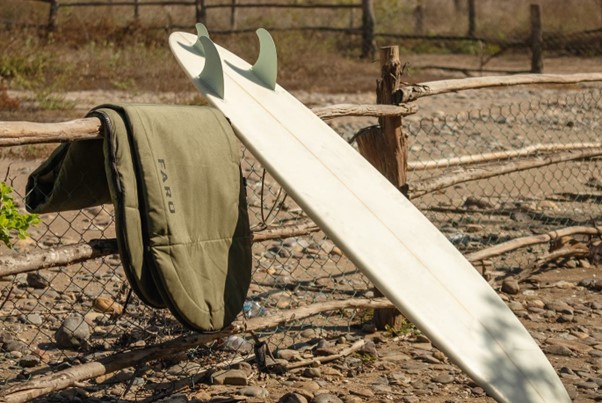Surfing is a learning curve that starts with picking out the right board for yourself. Choosing the perfect board depends on your skill level.
How to Choose the Perfect Surfboard for Your Skill Level
Whether you're just starting out in this sport or looking to upgrade your board, this guide brought to you by Faro Board Bags will help you navigate through the different types of surfboards to find your match. Let's dive in!
Understanding Surfboard Design
The shape, size, and materials used in a surfboard all play significant roles in its wave performance. The outline of a surfboard consists of key elements such as the nose, tail, and rocker - each contributing to how the board moves through the water. These elements also come into play when you're buying accessories like surfboard bags for your board.
Here's a breakdown of the key components:
- Length: Longer boards are generally more stable and easier to paddle, making them great for beginners. Shorter boards are more maneuverable and suited for advanced surfers.
- Width: Wider boards offer more stability, while narrower boards are quicker and more responsive.
- Thickness: Thicker boards float better and are easier to paddle. Thinner boards prove to provide more control for advanced maneuvers.
- Rocker: This is the curve of the board from nose to tail. More rocker means better performance in steep waves, while less rocker makes the board faster in smaller waves.
- Tail Shape: Different tail shapes affect how the board turns and holds in the wave. Common shapes include the squash tail (stable and versatile), the pintail (great for big waves), and the fish tail (offers speed and stability).


Finding Your Skill Level
Your experience in surfing will greatly impact the type of board that suits you best.
Are you a beginner just starting to catch waves? Or maybe you're an intermediate surfer looking to progress your skills further. Determining where you stand on the surfing spectrum will help simplify the surfboard picking process.
Beginners often benefit from longer and wider boards that provide stability and better flotation. As you advance in skill, shorter and more maneuverable boards may be more suitable for sharper turns and tricks on the waves.
Different board types offer different riding experience to surfers according to their experiences. So, take some time to honestly assess your abilities and comfort level in the water.
Types of Surfboards
Surfboards come in various shapes and sizes, each designed for specific wave conditions and riding styles.
One of the most common types is the longboard, which offers stability and ease of paddling. Ideal for beginners or those looking to catch smaller waves, longboards provide a smooth ride and are great for learning basic maneuvers.
Shortboards, on the other hand, are more maneuverable and responsive. These boards are suited for advanced riders who want to perform turns and tricks on larger waves. They require more skill to control but offer greater speed and agility in the water.
Fish boards have a wider shape that provides excellent floatation and stability. These are perfect for intermediate surfers looking to improve their skills. Fish boards offer a balance between performance and ease of use.
Choosing Your First Surfboard
The key to choosing your first board is finding one that suits your skill level and interests. Beginner surfers often go for longboards due to their stability and ease of paddling. These boards provide a solid foundation for learning the basics of surfing.
If you’re looking for a bit more maneuverability, funboards are a great option. They offer a balance between stability and performance, making them ideal for progressing beginners. Shortboards, on the other hand, are better suited for more advanced surfers who want to take on steeper waves and perform some cool tricks.
As you gain experience and improve, you can always upgrade to a different type of surfboard that better matches your skillset.
Factors to Consider
One key factor is the volume of the board, which affects its buoyancy and stability in the water. A board with higher volume will be easier to paddle and manage but may sacrifice some agility in the water.
The shape of the surfboard is also an extremely important consideration. Different designs cater to specific wave conditions and riding styles. For example, a longer board with a rounded nose is better suited for small waves and cruising, while a shorter board with a pointed nose performs well in larger waves.
Take the body weight and height of the surfer in consideration too when selecting a surfboard. A heavier surfer will require more volume in their board for their best performance, while taller individuals will benefit from a longer length to accommodate their stance on the wave.
Tips for Beginners
The first and most important tip for any beginner is that it's important to remember that practice makes perfect. Spend as much time as you can in the water, getting comfortable with your board and reading the waves.
Focus on your paddling technique. Strong paddling will help you catch more waves and improve your overall experience. Make sure to start on smaller waves before attempting larger ones to build up your confidence gradually. The ability to quickly get to your feet is essential, so practice your pop-up technique on land and in the water.
Board Protection
Just getting a surfboard isn't enough. You need to ensure your board remains safe in your quiver. When it comes to protecting your surfboard, getting a high-quality surfboard bag is essential. Faro Board Bags offers durable and well-designed bags that ensure your surfboard stays safe from dings, scratches, and UV damage. Whether you're traveling to a distant surf spot or just heading to your local beach, Faro’s surfboard protectors provide the perfect solution for transporting and storing your board. With various sizes and styles available, you're sure to find a bag that fits your needs and keeps your surfboard in top condition.
Conclusion
Choosing the perfect surfboard for your skill level is crucial to maximizing your enjoyment and progression in surfing. Understanding the design of surfboards, identifying your skill level, and considering factors like size, shape, and volume are key steps in making an informed decision.
Remember to always prioritize safety while surfing by using quality surfboard bags and protectors to keep your gear in top condition. By investing in the right equipment tailored to your abilities, you can ride the waves with ease and style.
Text and pics by Faro Board Bags
Without your Support, Waterwind wouldn't exist. Become our supporter!
If you want to advertise with us, read here, or contact us.
Collaborate with us. Read here!
Buy our Gadgets! Visit our YouTube channel!



